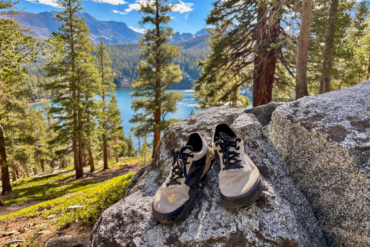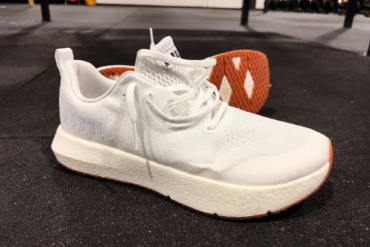A climber’s connection to rock (or indoor holds) is as dependent on feet and shoes as it is on hands and good grip. This article explains climbing shoes for someone just getting into the sport.
Rock climbing is a sport of subtle variation. Climbers ascend different types of rock, in different ways, and for long or short routes that can take anywhere from a few seconds to multiple days.
Climbing shoes are designed for every niche — bouldering, traditional, crack, sport, overhangs, approach, gym, and big walls — each with unique demands.
Here we break down the gamut of climbing footwear to help you pick your quiver. Experts Dan Hare, a 45-year climbing veteran and buyer at Golden, Colorado’s Neptune Mountaineering, and Dave Kassel, a manager at footwear giant Five Ten, offered advice to help distill the category of climbing shoes:
“I suggest beginners start on a less aggressive, more comfortable shoe,” said Kassel. He recommended a pair with a rounded toe, medium stiffness, and a neutral shape. “It takes a while to get used to the feel of climbing shoes [when you start the sport], and if you wear a pair with a lot of heel tension, downturned shape, and a pointy toe box, it won’t be as comfortable.” You’ll be focused on the pain of your feet, Kassel said, rather than technique or the moves on stone above.
Climbing Shoes Explained
Rock climbing shoes are critical gear for those who want to climb vertical stone. The “sticky rubber” of the sole provides a level of traction unlike any other type of shoe, allowing climbers to stand on barely-perceptible imperfections in otherwise blank rock.
The shoes tend to fit snug for high performance, and they are worn without socks. You’ll find climbing shoes vary widely, but a few important factors will help you chose one that’s right for you.
1) Climbing Shoe Fit
The cardinal rule? The fit of the shoe will depend on the shape of your feet, and it needs to feel good — meaning, fitted but not miserable or painful. To start, head to your local outdoors shop or a shoe demo at a climbing gym.
“Have an open mind, and try on as many pairs as possible, step on holds. Think about if you want that stiffness, like that shape, and if the shoe will feel good as it stretches out,” said Kassel. When you pull on the shoes your “toes should be curled a little bit, but not to the point where they are really crammed. For width, you want it snug around the foot, but not so tight that it’s painful,” Hare noted.
2) Climbing Shoe Shape
How a climbing shoe functions on rock, and how it feels on your foot, depends largely on its shape.

Neutral shoes have a nearly flat sole and “natural” feeling fit. They don’t force your foot into any strange positions, and you can stand on flat ground in them. These are a good choice for beginners and also work well in cracks, on easier trad routes, and for all-day climbs that don’t need extremely precise edging.
Moderate shoes have a slightly downturned toe and medium heel tension. “Stiff, moderate shapes offer a similar feel to moderately soft, aggressively shaped shoes. But, while they edge extremely well, they don’t smear as well and provide lower sensitivity, which is an ability to feel the holds so you can move your foot to the best position,” said Hare.
Aggressive shoes have a downturned, asymmetric shape with high heel tension. “A downturned shape in a moderately softer shoe offers powerful edging and smear-ability,” said Hare. These are great for hard climbing, but less comfortable and tend to be more specialized. They are not a great choice for beginners.
3) Rock Shoe Stiffness
Climbing shoes range from extremely stiff to buttery soft soles. “Stiffer is more supportive, which is less work for your feet. But, if you are going outside and climbing slabs, a softer pair might be more comfortable,” said Kassel.
Hare agreed: “Stiff shoes are often preferred for traditional climbing—or long days on rock, in general. The shoe gives more edging power when climbers are standing on holds. The feet don’t need to work as hard.”
Beginners are well served by a moderately stiff shoe that helps develop those toe muscles and ligaments. As you advance, a softer shoe will help feel tiny nubs of rock for a secure hold.
4) Toe Box
The toe box of a climbing shoe ranges from narrow and pointy to wide and boxy. The more aggressive the shoe, usually, the pointer the toe. “People with squared-off toes might prefer a wider toe box. People with a long big toe and toes that angle off might prefer a pointier shape,” said Hare.
5) Material and Stretch

Climbing shoes are made with uppers of leather, synthetic, or a “lined leather” that combines the two materials.
“Leather breathes better than synthetic,” said Hare. However, “leather shoes stretch out and get more comfortable with time.” The downside: If it stretches too much, the shoe might feel sloppy.
“Some people want a conformed shape and feel to be retained over time, so they go with synthetic,” said Kassel. “Un-lined leather can stretch up to 1/2 size; lined leather can stretch 1/4- to 1/2-size.”
6) Closure
Climbing shoes usually come with either lace-up or Velcro closures.
Velcro is nice for the ease of entry and exit, as the wide opening afforded by Velcro is often easier to slide in and out.
Lace-ups, while more time consuming to put on and take off, are more secure, especially in cracks where the top of the shoe is often jammed against the rock.
Another consideration: “A person with a wide or narrow foot might want a lace-up shoe for a wider range of adjustability,” said Kassel.
> Page 2: Tips: Choose Footwear According To Climbing Type









